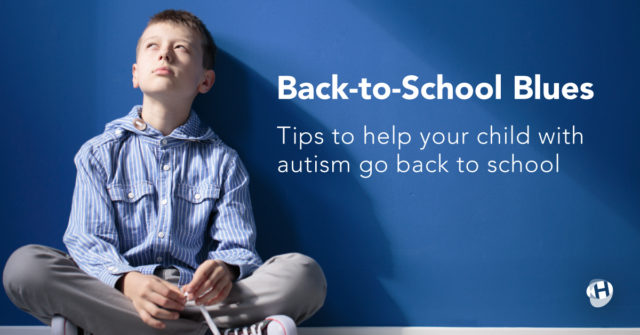Children have mixed feelings about going back to school. For some, it’s exciting to see all of their friends they missed over the summer. For others, the idea of leaving the freedom of summer behind sounds like anything but fun.

For children with autism, the back-to-school transition can be especially hard. Children with autism rely on structure and thrive when they have a consistent schedule. Going back to school interrupts the schedule they have had for three months, and that can be scary for them.
Parents of children with autism know them better than anyone. You know what your child likes and what triggers anxieties. It can be worrisome having your child seem uncomfortable with such a change, especially because you can’t be there during the day.
But have no fear, studies show children with autism do just fine getting back to school, as long as they are given the right support. Doctors and researchers have found there are ways to make this transition easier for your child with autism. To learn more, Johnson & Johnson talked to autism experts, such as Connie Kasari, Ph.D., an autism specialist and professor of human development and psychology at UCLA.
Elementary school children
- Visit the school before the year starts, and make a storybook outlining what they will be doing when they go to school
- Make a reminder note outlining exactly what your child needs to do in the morning, such as putting on a backpack and waiting for the bus, including photos on how to do it
- Create a student passport—a one-page paper with your child’s photo and details of likes and dislikes, how he or she communicates, things they can do themselves, things they need help with, what motivates them, and any triggers they have
- Plan a play date once school starts with new classmates
- Reach out to the teacher before school starts to set up a safe space where your child can go for a few minutes if he or she is overwhelmed or tired
Middle school children
- Visit the school before the year starts, help your child find his or her locker, show them how to use it and walk from classroom to classroom—almost like a trial run or dress rehearsal
- Adjust your child’s sleeping schedule to get them used to getting up earlier
- Ask the school to find peers who can be “lunch buddies” who can sit with your child
High school children
- Create a color-coding system for notebooks, binders, and folders for each individual school subject to help your child stay organized
- Set up after-school activities based on their interests
- Make a checklist of activities and put it in the bathroom to help them keep track of what to do to practice self-care
- Start planning for the future after high school, whether they will be taking the SAT or ACT, applying to school, or getting a job.
At the end of the day, you know your child better than anyone—so you may know ways you can modify or add to these tips to make them even better for your child as you prep for the return to school!
